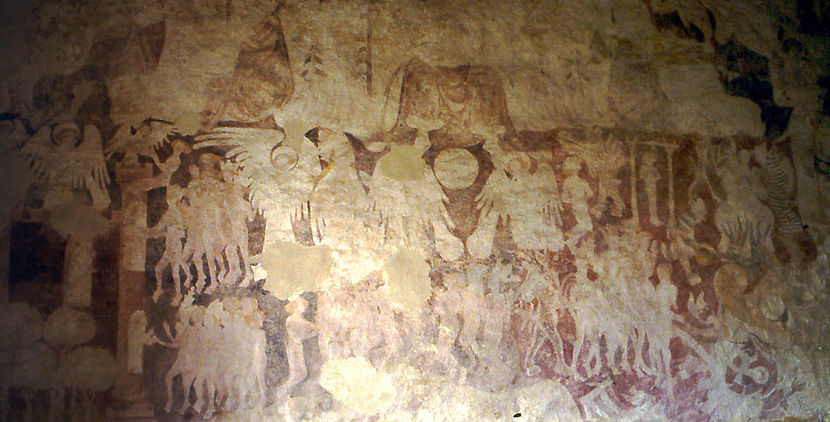Oddington, Gloucestershire (†Gloucester) C.13
Doom
This enormous Doom is on the north nave wall in the ancient church (dedicated to St Nicholas and not to be confused with the 19th century church at Oddington). Its size and the fact that paintings made later in the 15th century and now themselves dilapidated and confusing were superimposed on it, especially at the far right, makes it difficult to discuss or even photograph cogently.

Some details though are clear. The judging Christ sits centrally (the upper part of his figure has gone), with the orb of the world between his feet. Two angels, the one at the left here partly obliterated, sound bulbous trumpets below his feet. To the left of the partly obliterated angel is a tall figure recognisable as St Peter, crowned with the Papal tiara. Another angel, wings upraised and outspread further left, may be St Michael. Further left still, two groups of people, one group above and one below, head for the precincts of heaven. Crowned heads, including another pope wearing the tiara, are distinguishable in both groups. Angels lean out of the portals of a tall narrow tower to greet these people, with the possible exception of one individual poised at a perilous, backward-leaning angle close to but apparently ‘outside’ the crenellated parapet at the top of the tower. It is hard to be certain what is going on here, but the angel standing on top of the parapet may be either welcoming this soul or pushing it away, and thus of course, down. The possibility that this is a soul attempting to gain entry to heaven by illegitimate means – i.e. by scaling the external wall of the tower – is thus raised, although this effect may be entirely illusory.
There are more details at the extreme left of the painting but these are now mostly too faded to make anything out in detail. An exception however, is a third trumpeting angel beyond the tall tower, perhaps to remind the onlooker that the Last Trump will sound in heaven too.
Unusual details are also a feature of the right-hand side of this Doom, where the Damned are variously dealt with. One of the most interesting is to the right of the right-hand trumpeting angel. First, moving right, comes a kneeling, supplicant figure, and then further right another blurred figure which may be angel or devil, then after this a gibbet with a makeshift, roughly constructed look about it and a figure hanging from it. This kind of detail, which I have not seen in any other Doom, inevitably invites speculation, but the figure may be simply generic and representative of all those whose sins in life merit punishment in Hell, or Hell’s antechamber. To the right of this more commonly found hellish tortures are taking place, with what may be an oddly striped devil (one of several here) apparently using bellows on a fire burning with black flames below a large cauldron full of unfortunates. Below these details, is the Mouth of Hell itself, and moving back now towards the centre of the painting, a group of people, crowned and mitred heads among them again, are driven towards it by a tall and well-built devil notable for its hoof-like feet.
Further to the right of the north wall, and not shown here, the Doom becomes confused, sometimes hopelessly so, with another large subject which I can now identify with reasonable certainty as the Seven Deadly Sins. As with the Doom, some parts of this, notably a central figure representing Pride, are reasonably clear, and I will include the painting in these pages at some future date. But all in all, the Oddington Doom is one of the most interesting examples of the subject in England, and remarkable not merely for its size. Better photographs to do it justice will, I hope, be here at some future date.